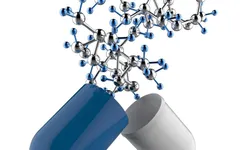
Pharmacology of Antibacterial Agents 
This course provides a comprehensive overview of the pharmacology of antibacterial agents, including pharmacokinetic and pharmacodynamic parameters, as well as insight into their proper and safe use. Developed by the Department of General and Clinical Pharmacology at RUDN University, this course is essential for those seeking a deeper understanding of antibacterial agents. ▼
ADVERTISEMENT
Course Feature
![]() Cost:
Cost:
Free
![]() Provider:
Provider:
Coursera
![]() Certificate:
Certificate:
Paid Certification
![]() Language:
Language:
English
![]() Start Date:
Start Date:
28th Feb, 2022
Course Overview
❗The content presented here is sourced directly from Coursera platform. For comprehensive course details, including enrollment information, simply click on the 'Go to class' link on our website.
Updated in [March 06th, 2023]
Learners can learn about the pharmacokinetic and pharmacodynamic parameters of the main groups of antibacterial agents, their proper and safe use, indications, contraindications, adverse drug reactions, and parameters of their safety and use in specific population of patients. They can also gain insight into the rational use of antibacterials, as well as the multimedia enriched videos, complementary educational material, interactive links to the actual articles and guidelines according to each module, and online Quizzes. Additionally, learners can gain a better understanding of the use of antibacterial agents in different medical specialties, such as General Medicine, Pharmacy, Dentistry, Pediatric, and Clinical Pharmacology.
[Applications]
Upon completion of the course, participants should be able to apply the knowledge acquired to the clinical practice. They should be able to identify the indications, contraindications, adverse drug reactions, and parameters of safety and use of the main classes of natural antibiotic and synthetic agents. They should also be able to assess the pharmacokinetic and pharmacodynamic parameters of the main groups of antibacterial agents and apply them to the rational use of antibacterial agents.
[Career Paths]
Recommended career paths:
1. Clinical Pharmacist: Clinical pharmacists are responsible for providing medication and drug information to healthcare professionals and patients. They also monitor patient drug therapies and provide advice on dosage, side effects, and drug interactions. Clinical pharmacists are in high demand due to the increasing complexity of medications and the need for more personalized patient care.
2. Pharmaceutical Researcher: Pharmaceutical researchers are responsible for researching and developing new drugs and treatments. They work in laboratories and use a variety of techniques to identify and develop new drugs. Pharmaceutical researchers must have a strong understanding of pharmacology, chemistry, and biology.
3. Pharmaceutical Sales Representative: Pharmaceutical sales representatives are responsible for promoting and selling pharmaceutical products to healthcare professionals. They must have a strong understanding of the products they are selling and be able to effectively communicate the benefits of the products to potential customers.
4. Regulatory Affairs Specialist: Regulatory affairs specialists are responsible for ensuring that pharmaceutical products comply with all applicable laws and regulations. They must have a strong understanding of the regulatory environment and be able to effectively communicate with regulatory agencies. Regulatory affairs specialists are in high demand due to the increasing complexity of regulations.
[Education Paths]
Recommended Degree Paths:
1. Doctor of Pharmacy (PharmD): This degree program is designed to prepare students to become licensed pharmacists. It focuses on the clinical aspects of pharmacology, including the use of drugs to treat diseases, the side effects of drugs, and the interactions between drugs. Students will also learn about the legal and ethical aspects of pharmacy practice. This degree is becoming increasingly popular as the demand for pharmacists grows.
2. Master of Science in Clinical Pharmacology: This degree program focuses on the clinical aspects of pharmacology, including the use of drugs to treat diseases, the side effects of drugs, and the interactions between drugs. Students will also learn about the legal and ethical aspects of pharmacy practice. This degree is becoming increasingly popular as the demand for pharmacists grows.
3. Doctor of Philosophy in Pharmacology: This degree program focuses on the scientific aspects of pharmacology, including the study of the mechanisms of action of drugs, the development of new drugs, and the evaluation of drug safety and efficacy. Students will also learn about the legal and ethical aspects of drug development and use. This degree is becoming increasingly popular as the demand for pharmacologists grows.
4. Master of Science in Pharmaceutical Sciences: This degree program focuses on the scientific aspects of pharmacology, including the study of the mechanisms of action of drugs, the development of new drugs, and the evaluation of drug safety and efficacy. Students will also learn about the legal and ethical aspects of drug development and use. This degree is becoming increasingly popular as the demand for pharmaceutical scientists grows.
Course Syllabus
Introduction to the course of Pharmacology of antibacterial agents. Rational antibiotic therapy
Week 1 is “Introduction to the course of Pharmacology of antibacterial agents. Rational antibiotic therapy”, which is aimed on consideration of the actual problems of antibiotic use.Pharmacodynamics of antibacterial drugs
Week 2 is “Pharmacodynamics of antibacterial drugs”, highlighting the main mechanisms of antibacterial action, types of effects, general mechanisms of antibacterial resistance development and strategies to overcome it.Pharmacokinetics of antibacterial agents
Week 3 is “Pharmacokinetics of antibacterial agents”, dedicated to next parameters, absorption and bioavailability, distribution, and elimination, as well as to pharmacokinetic drug interactions.Beta-lactam antibiotics. Penicillins
Week 4 is “Beta-lactam antibiotics. Penicillins”, it includes the questions of beta-lactams classification with consideration of penicillins pharmacodynamic and pharmacokinetic parameters, indications, contraindications, adverse drug reactions including penicilliun-induced allergy, resistance mechanisms and ways to fight them.Beta-lactams. Cephalosporins. Carbapenems. Monobactams
Week 5 is “Beta-lactams. Cephalosporins. Carbapenems. Monobactams”, dedicated to the named groups of beta-lactam antibiotics and the actual parameters of their effective and safe use.Pharmacology of natural antibiotics
Week 6 is “Pharmacology of natural antibiotics”, covering the main pharmacologic characteristics and actual problems of effective and safe use of Tetracyclines, Aminoglycosides, Macrolides, Glycopeptides, Streptogramins, Lipopeptides, Lincosamides.Pharmacology of antibacterials of synthetic origin
Week 7 is “Pharmacology of antibacterials of synthetic origin”, dedicated to the main parameters of pharmacokinetics and pharmacodynamics, indications, contraindications, adverse drug reactions and safe use of Quinolones/Fluoroquinolones, Phenicols, and Oxazolidinones.Pharmacology of antibacterial drugs against Mycobacterium tuberculosis
Week 8 is “Pharmacology of antibacterial drugs against Mycobacterium tuberculosis”, which is aimed on providing information about pharmacologic characteristics of the first line antituberculosis agents and highlining the actual problems of their safe use.Antibacterial agents’ safety. Part I
Week 9 is “Antibacterial agents’ safety. Part I”, covering the actual problems of antibiotic-induced cardiotoxicity, nephrotoxicity, adverse drug effect involving skeletal muscles.Antibacterial agents’ safety. Part II
Week 10 is “Antibacterial agents’ safety. Part II”, which includes actual questions regarding antibiotic-associated neurotoxicity, gastrotoxicity, and hematotoxicity.Antibacterial agents use in special populations
Week 11 is “Antibacterial agents use in special populations”, highlining the main problems of safe and effective antibiotic use in pediatric practice, in elderly and geriatric patients, in hepatic or renal failure.Course Provider

Provider Coursera's Stats at AZClass
Discussion and Reviews
0.0 (Based on 0 reviews)
Explore Similar Online Courses

Branding and Customer Experience

Tworzenie Wizualizacji 3D Blender dla poczatkujacych

Python for Informatics: Exploring Information

Social Network Analysis

Introduction to Systematic Review and Meta-Analysis

The Analytics Edge

DCO042 - Python For Informatics

Causal Diagrams: Draw Your Assumptions Before Your Conclusions

Whole genome sequencing of bacterial genomes - tools and applications

Birth of a drug

Pharmacology

Pharmacology & Cardiovascular Health
 Related Categories
Related Categories
 Popular Providers
Popular Providers
Quiz
 Submitted Sucessfully
Submitted Sucessfully
1. What is the main objective of the course “Pharmacology of antibacterial agents”?
2. Who is the course “Pharmacology of antibacterial agents” intended for?
3. What type of multimedia is used in the course “Pharmacology of antibacterial agents”?
4. What is the main objective of the course 'Pharmacology of Antibacterial Agents'?
Correct Answer: To provide systemic knowledge on pharmacokinetic and pharmacodynamic parameters of the main groups of antibacterial agents and insight into their proper and safe use.


Start your review of Pharmacology of Antibacterial Agents